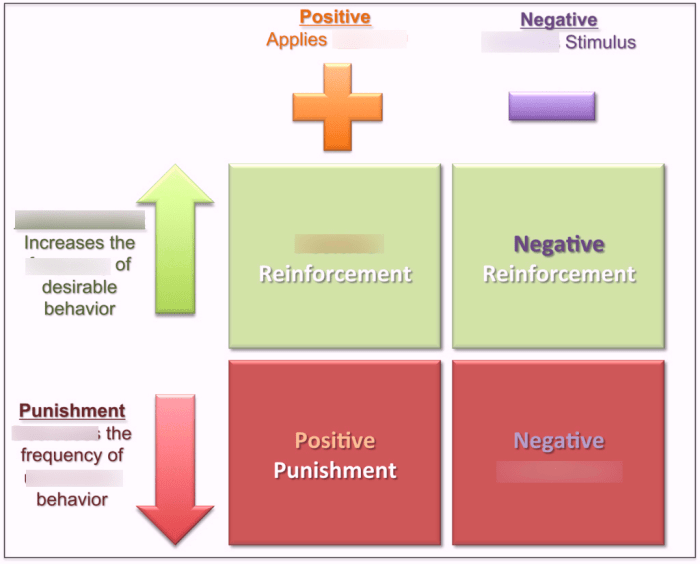Learning positive and negative reinforcement worksheet answers – Unveiling the profound impact of reinforcement on behavior, this comprehensive guide delves into the intricate mechanisms of positive and negative reinforcement, empowering educators and therapists with practical worksheet answers for transformative learning experiences.
Through a meticulous examination of reinforcement principles, we illuminate the role of rewards and punishments in shaping behaviors, providing invaluable insights into the ethical considerations and diverse applications of reinforcement techniques in educational and therapeutic settings.
Positive and Negative Reinforcement

Positive and negative reinforcement are two types of operant conditioning that involve the use of rewards or punishments to increase or decrease the likelihood of a behavior occurring. Positive reinforcement involves providing a reward after a desired behavior is exhibited, while negative reinforcement involves removing an unpleasant stimulus after a desired behavior is exhibited.
Examples of Positive Reinforcement
- Giving a child a candy after they clean their room.
- Praising a student for answering a question correctly.
- Providing a bonus to an employee for exceeding their sales goals.
Examples of Negative Reinforcement
- Taking away a child’s screen time after they misbehave.
- Turning off a loud noise after a baby stops crying.
- Allowing a prisoner to leave their cell after they have completed their chores.
Learning through Positive and Negative Reinforcement: Learning Positive And Negative Reinforcement Worksheet Answers

Positive and negative reinforcement can both be effective in increasing or decreasing the likelihood of a behavior occurring. However, positive reinforcement is generally considered to be more effective than negative reinforcement because it is less likely to cause negative side effects such as fear or anxiety.
The Role of Rewards and Punishments in Reinforcement Learning, Learning positive and negative reinforcement worksheet answers
Rewards and punishments are the two main components of reinforcement learning. Rewards are positive stimuli that are given after a desired behavior is exhibited, while punishments are negative stimuli that are given after an undesired behavior is exhibited.
Examples of How Positive and Negative Reinforcement Can Be Used to Teach New Behaviors
- Positive reinforcement:A child is given a sticker every time they say “please” and “thank you.”
- Negative reinforcement:A child is allowed to leave the dinner table after they have eaten all of their vegetables.
Using a Worksheet to Analyze Reinforcement

A worksheet can be a helpful tool for analyzing the use of positive and negative reinforcement. The worksheet can include a table with columns for the following information:
- Behavior
- Antecedent
- Consequence
- Type of reinforcement
- Effectiveness
Instructions for Using the Worksheet
- Observe the behavior you want to analyze.
- Identify the antecedent, which is the event or stimulus that occurs before the behavior.
- Identify the consequence, which is the event or stimulus that occurs after the behavior.
- Determine the type of reinforcement, which can be positive or negative.
- Rate the effectiveness of the reinforcement, which can be high, medium, or low.
Sample Data
| Behavior | Antecedent | Consequence | Type of reinforcement | Effectiveness |
|---|---|---|---|---|
| Cleaning up toys | Asking the child to clean up their toys | Giving the child a sticker | Positive reinforcement | High |
| Crying | The child is tired | Taking the child to bed | Negative reinforcement | Medium |
Ethical Considerations in Using Reinforcement
There are several ethical considerations that should be taken into account when using positive and negative reinforcement. First, it is important to ensure that the reinforcement is not harmful to the individual. Second, it is important to use reinforcement in a way that does not promote dependency or control.
Third, it is important to respect the individual’s autonomy and choice.
Potential Risks and Benefits of Using Reinforcement Techniques
Potential risks:
- Coercion or control
- Diminished intrinsic motivation
- Negative side effects (e.g., fear, anxiety)
Potential benefits:
- Increased compliance
- Improved behavior
- Enhanced learning
Guidelines for Using Reinforcement Ethically
- Use reinforcement in a way that is respectful of the individual’s autonomy and choice.
- Use the least intrusive method of reinforcement that is effective.
- Monitor the use of reinforcement regularly to ensure that it is not causing any negative side effects.
Applications of Reinforcement in Education and Therapy

Positive and negative reinforcement can be used in a variety of educational and therapeutic settings to increase or decrease the likelihood of certain behaviors occurring. For example, positive reinforcement can be used to reward students for completing their homework, while negative reinforcement can be used to discourage students from misbehaving.
Examples of How Reinforcement Techniques Have Been Used Successfully in These Settings
- Education:A teacher uses a token economy to reward students for positive behavior, such as completing assignments and participating in class.
- Therapy:A therapist uses positive reinforcement to help a client overcome their fear of spiders.
FAQ Guide
What are the key differences between positive and negative reinforcement?
Positive reinforcement involves adding a pleasant consequence to increase the likelihood of a behavior, while negative reinforcement involves removing an unpleasant consequence to achieve the same effect.
How can I effectively use a worksheet to analyze reinforcement?
Design a worksheet that includes sections for recording the behavior, the type of reinforcement used, and the observed effects. Collect data over time to identify patterns and adjust reinforcement strategies accordingly.
What are the ethical considerations when using reinforcement techniques?
Ensure that reinforcement is used fairly, consistently, and in a manner that respects the individual’s autonomy and well-being. Avoid using punishment or excessive rewards that could have negative consequences.